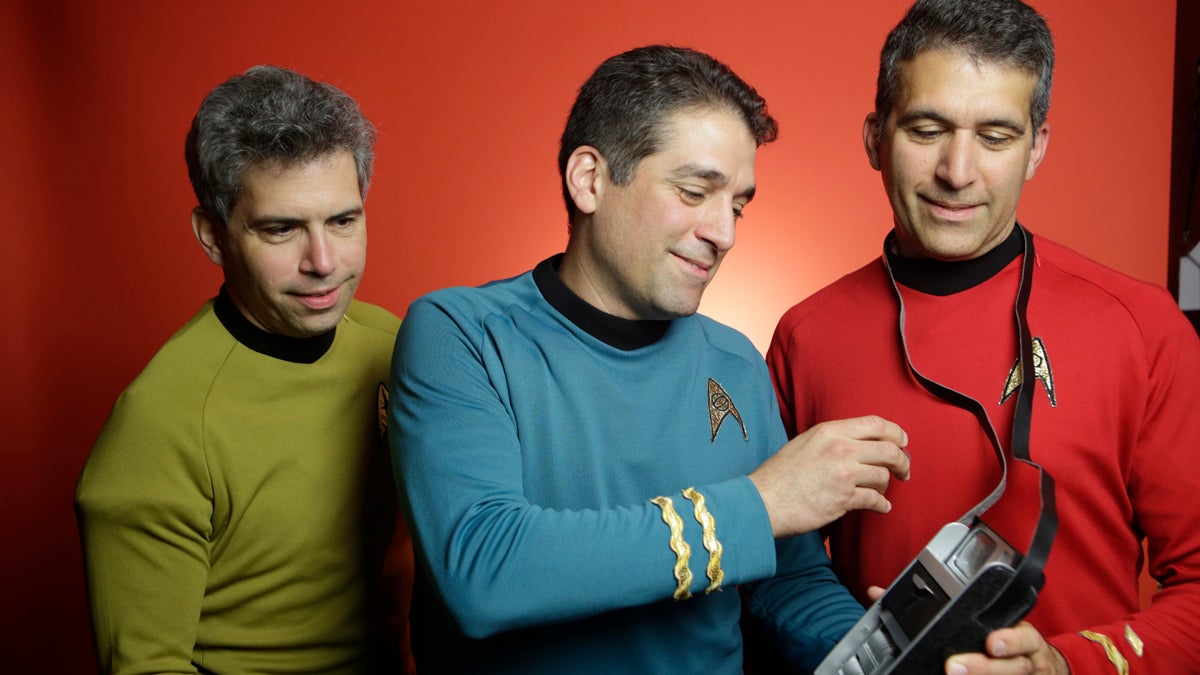Stranger than fiction: Star Trek’s ‘tricorder’ could soon be a reality
Listen
Members of the Final Frontier Medical Devices team geeked out in Star Trek gear
The tale of a high-stakes medical device competition inspired by a sci-fi classic and a local team boldly going into the finals.
It all starts with the very first season of Star Trek, a dream of the 1960s, and one Dr. Leonard McCoy. His go-to gadget: the “tricorder” — a handheld device, about the size of an old tape recorder, used for scanning unfamiliar places, recording technical data, and diagnosing the many ailments encountered by the crew of the Starship Enterprise.
It lived on in the Star Trek universe, evolving over time, but now, here on 21st-century Earth, the tricorder may become a real-life medical instrument. The final frontier is here, maybe — in the form of one Basil Harris, an ER doctor at Lankenau Hospital in Wynnewood, Pa.
“I was an engineer in a former life, and always interested in technology, grew up with tons of science fiction around,” Harris said. “And when I heard about this prize, it was immediately intriguing.”
That prize is the Qualcomm Tricorder XPRIZE, a challenge that dangles a $10-million carrot to build the next great consumer-focused health tool. (You may have heard of the Automotive XPRIZE or the Lunar XPRIZE. It’s organized by the same outfit.) Harris’ team, called Final Frontier Medical Devices, was recently announced as one of ten finalists worldwide. Harris’ two brothers and a sister are among those on the squad.
How it works
“So the idea of the tricorder originally in the Star Trek world was a device that was still in the hands of Dr. McCoy,” Harris, dressed in scrubs, explained to a reporter in a spare exam room last month.
But the entries into the tricorder competition will have to go beyond that.
“What XPRIZE has done is actually taken it a step further and taken the doctor out of the equation, making it into an autonomous device,” he added.
You can think of it as a really souped up thermometer that scans and records your vital signs and other health metrics, and then—and this is the hard part—it offers up a diagnosis of what’s wrong with you.
“It guides you through a process and has a dynamic flow to it, so if you have a certain set of symptoms, it’ll guide you toward a certain set of tests that you might need,” Harris said of his team’s approach to the tricorder.
Using a tablet and a few wireless monitoring devices, they’re turning to the power of algorithms to put a doctor in the palm of your hand—something that “asks” you questions and guides you to the proper course of medical action. It’s a high bar to hit.
“It’s a huge responsibility,” Harris said. “And that is why we’ve done a validation study on our algorithms based on real medical data from actual patients with these conditions to understand: are these algorithms robust enough?”
It’s an approach that makes Harris’s team stand out—for better or worse. For instance, their device, unlike some other teams, doesn’t deal with blood samples.
Dr. Erik Viirre, the technical and medical director of the Tricorder XPRIZE, says most of Final Frontier’s competitors are taking a more a sensor-heavy approach.
“However, the Final Frontier team has really hung their hat on artificial intelligence,” Viirre said. “Their goal is to use artificial intelligence systems to be able to make queries to people and then use that to zero in on the possible medical conditions a person might have.”
Viirre is also a physician at UC San Diego, and that’s where the next big milestone in the XPRIZE competition takes place.
Next summer the ten finalists have to deliver their prototype tricorders so they can be rigorously tested on volunteer patients suffering from the diseases outlined by the competition—there’s over a dozen of them, ranging from sleep apnea to stroke to tuberculosis.
The device that can most accurately pinpoint the health conditions, wins the big prize.
“What we want to accomplish in our competition is to demonstrate the feasibility, the reality of that,” Viirre said.
Viirre is a Trekkie himself, and a proud owner of his own Star Trek uniform—the blue one, of course, from sickbay. He says building another thing from Star Trek will be cool enough in and of itself. I mean, we already have mobile phones, which are kinda like the show’s communicators.
“All joking aside, I think one of the most important things that will happen from our competition is the use of the word ‘tricorder,'” said Viirre. “I think ‘tricorder’ will become one of these words like kleenex that ultimately becomes part of the parlance.”
My tricorder says to check my cholesterol today. My tricorder says I need to go to the doctor. That kind of stuff. It’s a grand vision shared by Basil Harris back at Lankenau Hospital, right outside Philly’s city limits.
Harris says his emergency room work has absolutely informed how he’s approaching this tricorder thing. Namely: patient first.
“I work here in the ER all the time, and people come in with little scraps of paper with their blood pressure readings, their glucose readings,” Harris said. “I imagine a day when patients are coming in and saying, ‘Hey, I have this tricorder device, and it’s telling me that I have pneumonia.’ And I want to be at a point where I trust that data.”
It’s still very early, Harris cautions. But he seems confident we’ll get there.
“There are many hurdles to achieve that level through the FDA, through regulatory processes, but that’s the future,” he said.
Consider it a moonshot within reach—another once-wacky idea from science fiction made real.
WHYY is your source for fact-based, in-depth journalism and information. As a nonprofit organization, we rely on financial support from readers like you. Please give today.



